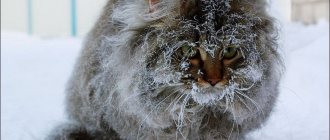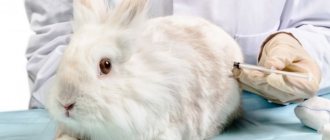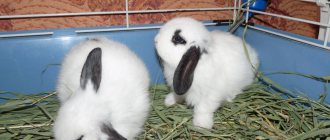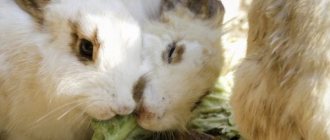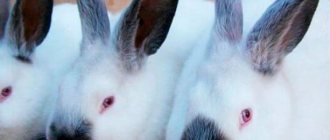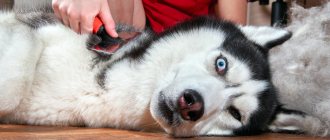For some rabbit breeders, the onset of cold weather is sometimes very scary. in a special way in winter , but this will not be much effort for those who know how to keep and breed rabbits correctly. But before the onset of frost, animals should be properly and responsibly prepared . The rabbit has its own warm fur, but it will still have to create all the necessary conditions. This is necessary in order to avoid illnesses and frostbite that can be associated with extreme cold.
Winter keeping rabbits outside
Only experienced rabbit breeders know about all the benefits of keeping and raising rabbits outside throughout the year. Here is a list of advantages for those who have no experience and are just starting to deal with these cute animals:
- Rabbits do not breathe toxic substances due to the lack of ammonia evaporation (and it is one of the main reasons for the extinction of these animals);
- Infectious diseases do not appear in winter;
- Financial costs in winter are much lower. Building a winter cage or greenhouse will cost you much less than building a summer shed;
- Frosty winter air helps animals acquire strong immunity and harden themselves.
When an owner without experience in rabbit breeding becomes familiar with all the nuances and skills of winter keeping rabbits, he will notice immediate benefits in such keeping .
Features of keeping in an enclosure
Before moving in, animals must be dewormed and vaccinated. It is necessary to examine all pets for signs of ill health. If there is a sick individual in the enclosure, the others will also become infected. Features of accommodation and maintenance:
- All animals are released at the same time. In an unfamiliar environment, they will not fight, but will behave calmly. Old-timers usually do not accept a newcomer.
- Females that grew up together get along best with each other.
- Males are kept separately in cages or enclosures; they themselves will divide the territory among themselves. When it is necessary to mate, the female rabbit in heat is placed next to the rabbit.
- All rabbits that have reached three months of age are separated to prevent inbreeding.
Important! Aggressive individuals are always separated from the livestock; it is better to keep them in cages.
The diet for keeping rabbits in enclosures is no different from the usual. Animals are given feed, vegetables, grass and hay, as well as branches for grinding down teeth. It is important to ensure that animals always have access to drinking water. What are the advantages and disadvantages of enclosure keeping, we will consider further.
Rabbit food
Advantages
Keeping rabbits in an enclosure has a number of advantages:
- Economical. The arrangement and construction of an enclosure requires less building materials and equipment.
- Reduced labor costs. It is easier for a farmer to restore order in an enclosure than in several cages. Distributing food also does not take much time and effort; the main thing is to correctly calculate the amount of food for all individuals.
- Good physical condition of pets. Rabbits move a lot, live in conditions close to natural, due to which their immunity is strengthened.
- Food for baby rabbits. The cubs will not be left without mother's milk. All the rabbits in the enclosure smell the same, which means that if their mother does not have enough milk, they can be fed by another neighboring rabbit.
How to keep rabbits in winter - tips
feel great outside in winter . But have you forgotten about the comfort of such pets? After all, no one gives you a guarantee that at very low temperatures the animals will not die.
Rabbits do not mate very actively if the outside temperatures are low. At the same time, they very quickly gain body weight in order to provide themselves with energy to heat it up. The result of this is low fertility due to decreased reproduction. There is no hope for replenishment in such conditions.
In severe frosts, young individuals and pregnant females do not feel the best. But don't be afraid. There have even been cases when animals were kept at temperatures of 30 degrees below zero. The fluffies reproduced normally and felt great.
It is because of this that special attention should be paid to the construction of a home or greenhouse for fluffies.
How to care for rabbits in winter: winter maintenance methods
The choice of option for keeping pets should be based on the specifics of the animal breed, the average weather in the region, and available resources. In the case of mild winters, preference should be given to cages.
It makes the most sense to house rabbits in isolated sheds where there is no high humidity or drafts.
The choice of option for keeping pets should be based on the specifics of the animal breed.
An important condition is the presence of bedding (in the form of sawdust, hay or straw). An alternative to a shed is a garage or greenhouse. During severe frosts, electric heaters should be used indoors.
There is an option with pit housing for individuals. The walls and floor of the depression in the soil are insulated with slate, concrete or other materials that will not allow animals to dig deep holes.
The fenced pit is covered with soil, where the pets eventually break through a network of passages. The animals stay underground during frosts, climbing to the surface to feed.
Sheds will serve as a combined housing option. The structures look like cells arranged in rows, tiers or cascades. There are through passages in the shad floors, which provide the animals with the opportunity to move freely. The method is adopted by rabbit breeders who need to care for large numbers of animals.
The organization of polycarbonate greenhouses looks like a non-standard way of maintaining them. The owners place a metal mesh around the structure, immersing the structure into the soil to a depth of 0.5 m. The solution avoids animals digging up the soil.
Important! Polycarbonate transfers and conducts heat well. In order for a dwelling made of such material to provide comfortable conditions in the cold, the walls must be treated with water-based paint or lime.
Arranging your home for the winter
This issue is very important when keeping rabbits in winter and should be given maximum attention. It is best to fill the space between the cage and the walls with natural heat insulators. These include:
- Foam or felt;
- Small tree branches;
- Moss;
- Dry straw;
- Dry leaves of bushes and trees.
Feeders for rabbits - description and manufacturing diagrams
If the floor has a mesh structure, then it must be covered with a very thick layer of dry straw. You can also lay out the floor in the cage with thick wooden boards. On days when bad weather and frost are severe outside, you should wrap your pet’s cage well with warm clothes or a cotton blanket. Almost all experienced rabbit breeders fill the internal spaces with hay. While breathing, rabbits heat the air and this heat, thanks to the hay, is stored for a long time.
The easiest way to help keep cages warm and cozy is to raise them to a height of 85 centimeters above the floor. The houses can also be insulated on the outside. To do this, place iron overlapping the roof. This will prevent water from getting inside.
Preparing cells for cold weather
The cages in which your rabbits will winter need to be prepared for the cold. That is, carry out the following operations.
- Insulate the floor. If the cage has a mesh floor, then lay thick boards on top, and put deep bedding on the boards.
- Insulate the door. In order not to impede the penetration of sunlight and not to reduce short winter days, use transparent materials for insulation - plexiglass, polycarbonate or a glazed frame.
- Insulate the walls on all sides. First of all, you need to caulk all the cracks so that snow does not sweep into them and the wind does not whistle. For these purposes, you can use tow and felt. Then cover it with a blanket or any modern insulation. Cover with waterproof material - film, roofing felt, plywood. It is better to insulate not inside the cage, but outside.
In the spring, all insulation must be removed so that fungus does not develop, rot does not spread, and with them infections and pathogenic microbes.
Cell placement
In winter, it is important to use all the possibilities of natural heating from the sun's rays. Therefore, cages with rabbits on the site should be located where the sun lasts longer and more. And also in a place protected from the wind. That is, behind buildings, preferably permanent ones, and on the south side.
Breeding rabbits in winter and giving birth in winter
No one will doubt that rabbits born in winter have better health and grow faster. And their fur is much better and of higher quality than that of rabbits born in any other period of the year. Such seasoned animals will in the future produce more productive females and excellent producers.
Mating of these whimsical animals in winter is carried out according to a special regime. At the same time, it is important to know and take into account that an older female, which has already been repeatedly used in litters, is best suited for covering. It is also important to take into account how capable she will be of feeding the babies on her own, using her own milk.
It is recommended to mate these animals on days when severe frosts are not expected. It is recommended to do this during the day. Beginner rabbit breeders want to get offspring faster. But they forget that nothing good should be expected from increased births that occur in severe frosts.
In winter, litter can be obtained even from rabbits living outside. And by following all the rules, you can reduce costs to a minimum amount. The result will be more noticeable if you choose those females that can give more than two litters in one winter .
Here’s what you need to know in order to carry out childbirth in winter and further lactation:
- It is necessary to prepare and insulate the cages well: create conditions in them favorable for mating of animals;
- Provide artificial lighting in the queen cell in advance to create longer daylight hours;
- The queen cell must be prepared and equipped, following all the rules;
- Provide animals with food and warm water on time.
By following all these rules, you will be able to receive additional income in the winter from breeding such a farm.
Rabbit breeding as a business: profitable or not?
Construction and arrangement of an enclosure
An enclosure is a limited space that is fenced with mesh or other materials around the perimeter. Most often it does not have a roof or is equipped with a canopy partially to protect animals from precipitation.
Accommodation requirements
Before you start building an enclosure for rabbits, you need to choose a suitable place where it will be located. The main requirement for placement is that the enclosure is installed in an elevated place to avoid flooding during rainy periods and melting snow. In the southern regions, farmers recommend installing an enclosure in the light shade of trees to protect their pets from overheating. In the northern regions, they do things differently - housing for rabbits is placed in the open sun.
How to correctly calculate the area of the enclosure?
Having decided on the location, you need to correctly calculate the area of the structure. It is determined based on the number of livestock. On average, each rabbit should have at least 0.7 m2. Rabbits with baby rabbits will need more space. The optimal value is 1 m2 for each adult.
Construction Materials
To build an enclosure with your own hands you will need building materials:
- bars;
- board;
- metal mesh;
- supports (you can use pipes or metal pegs);
- shovel;
- screws, nails;
- screwdriver;
- door hinges;
- lock;
- slate;
- sand;
- sawdust.
Attention! It is important to correctly calculate the perimeter of the enclosure in order to purchase the required amount of mesh, boards and slate. It should be taken into account that the side parts of the enclosure are dug to a depth of at least 0.8 m so that the rabbits cannot dig under the ground and escape.
Construction phase
Having chosen a suitable place on the site to build an enclosure for rabbits, you need to take measurements and draw markings. At the initial stage, a ditch is dug into which the walls of the slate structure will be deepened. Supports are dug into the corners to a depth of 0.8 m. Sheets of slate are placed in the recesses (it is more convenient to use flat slate). They are fastened together. The ditch is filled with earth and compacted, and the site is leveled.
The mesh is attached to the metal corner supports using self-tapping screws. The height of the walls of the structure is 1 m. It is advisable to cover the back of the structure with a board to protect the animals from drafts. A door is installed on the front or one of the side walls.
The top layer of soil inside the enclosure to a depth of 15 cm must be removed, and sand should be poured in its place. A mesh is fixed over the sand layer, onto which sawdust is then poured. Some farmers leave the dirt floor, others concrete it and then insulate it with bedding.
Attention! Not all breeds are able to live on a mesh floor. Heavier rabbits and those with sparsely furred feet will suffer from pododermatitis.
Mandatory attributes of the enclosure are shelters - houses made of wood, where pets will hide when they are cold or scared, and rabbits with litter also need such shelters. It is in them that the birth occurs.
If desired, you can build a small canopy over the structure; it will protect the rabbits from the hot sun, rain and snow. Drinkers and feeders are installed inside the enclosure. It is important to ensure that this equipment meets the needs of the entire livestock, otherwise the rabbits will fight for food and water. You can move eared animals into your finished home.
How to prepare a queen cell
In the cold winter, pregnant females and small newborn rabbits need appropriate care . When the outside air temperature is below 25 degrees, the female rabbit can give birth. Under these conditions, babies survive only when the queen cell is well insulated and properly equipped. Before breeding, the rabbit breeder must thoroughly insulate the facade part, which consists of a mesh and the mesh itself.
Covering the mother plant with garden agro-cloth or polystyrene foam will help protect the mother plant from frost. The cracks need to be sealed perfectly. This is necessary so that the wind does not get into the middle of the queen cell. The mesh floor in the queen cell must be covered with a sheet of oranite of the required size or thick cardboard. After this, cover it with bedding. If you prepare the queen cell located outside in this way, the breeding will take place without any incidents.
In winter, a female can bring her offspring, even if the air temperature outside is 20 degrees below zero. A prerequisite for normal breeding in winter is proper ventilation and impeccable cleanliness in the queen cell. If all these conditions are not met, the female will begin to take poor care of her babies. And this leads to a lag in development and growth, and possibly even to the death of the rabbits.
How to feed rabbits in winter
If you decide to raise rabbits outside in winter, then focus on how to properly organize feeding and what food to choose for this. In winter, food should have a higher calorie content. At this time, the animals use maximum energy to warm their bodies. Therefore, if they are given meager food, the animal’s immunity will weaken due to a decrease in the fat layer. As a result, resistance to low temperatures weakens due to decreased energy.
Feeding must be organized in such a way that the diet of rabbits during the winter period has maximum nutritional value . The rate of roughage and concentrated feed should be slightly increased compared to the amount in the summer. The most suitable option for winter feeding of rabbits kept outside is mash, which must be given to them warm.
Winter feeding must be carried out according to a certain regime. These fastidious animals need to be fed at least six times a day, otherwise they will start to freeze. You should also ensure that the food left after feeding does not freeze. Leftover food should be removed after each feeding.
On cold days, it is recommended to add minerals and vitamins . They must be purchased from veterinary pharmacies. Excellent food would be Jerusalem artichoke, carrots and fodder beets. Potatoes can be given boiled. All these products will ensure an increase in the animal’s weight. And this will contribute to the comfortable keeping of rabbits outside during the winter.
What to feed a decorative rabbit
Winter diet
In winter, rabbits require increased nutrition. The menu for pets should include concentrated food, food containing coarse dietary fiber, raw and boiled vegetables (potatoes, Jerusalem artichoke, fodder beets, cabbage, carrots).
Note! It is important to give your pets a warm mash of grain mixture daily, consisting of crushed barley, millet and corn.
The winter rabbit menu is particularly nutritious
To ensure that the animals' teeth are ground down in a timely manner, they are offered branches of trees and shrubs prepared in advance. It is best to give preference to the following types:
- oak;
- birch;
- willow;
- alder;
- poplar;
- maple;
- needles (without needles).
How to drink if the water freezes
In winter, it is very important to properly organize the feeding process for animals. The easiest way is to invest in a heated sippy cup. The water in it will not freeze, and the rabbits will be able to get it at will at any time. However, many rabbit breeders may not be able to afford such equipment. In this case, you should offer your pets water at least twice a day, and it should be warm.
What vitamins to give
Often in winter, rabbits are deficient in vital vitamins. To compensate for the lack of vitamins A and D, you need to add fish oil to your food. The lack of vitamin E is compensated by adding yeast to the grain mixture.
For your information! If you regularly feed your rabbit sprouted grain, seasonal vitamin deficiency will be avoided.
To prevent a rabbit from suffering from diseases caused by decreased immunity, it is necessary to maintain a mineral-salt balance in its body. To do this, a mixture of chalk, bone meal and iodized salt is introduced into the animal’s diet.
How to feed pregnant and lactating females in winter
Increased attention is paid to those females who are chosen for littering. For this purpose they are prepared in advance. This applies to cleanliness and the organization of animal feeding. Lactating and pregnant females , as well as the breeding male, need minerals and vitamin feed in the winter. Granulated feed and mixed feed will help the rabbit breeder with this . All necessary components are included in their composition.
Be sure to include boiled potatoes, carrots and sprouted oats in the diet of expectant mothers. The female must be fully provided with concentrated feed for the entire gestation period and 14 days after giving birth.
Branch food for rabbits
Domestic rabbits do not neglect branch food. Beginning rabbit breeders need to take this into account. be fed with tree branches . Animals eat this food with great pleasure. Among other things, they grind down their teeth and do not harm the cells. It is also important to know that the branches contain trace elements and vitamins in large quantities. By giving them, you will add variety to the animals’ diet. Each bark has its own taste and beneficial properties. You can give branches from almost all types of trees:
- Pine and spruce;
- Poplar and maple branches;
- Mulberry and grape branches;
- Acacia branches;
- Oak;
- Willows;
- Alder;
- Birch;
- Appleaceae.
The bark of aspen and willow contains elements with antimicrobial action , which will help get rid of existing animal diseases. Branches can also help out a rabbit breeder if there is no hay. Tree branches support the emotional health of the animal. The length and thickness of the branches should be like a bath broom. The branches should not be exposed to direct rays of the sun when drying. The maximum amount of vitamins is contained in grape leaves and vines.
Caring for a decorative rabbit
Rabbit fur care
A decorative rabbit must be combed twice a week. For this, a special brush or furminator is usually used. During the molting period, the down of rabbits must be monitored especially carefully. The combing procedure should bring pleasure not only to the pet, but also to its owner.
To avoid tangles and tangles in long-haired animals, you can use various hair care products and sprays. After such procedures, the fur of a decorative rabbit becomes beautiful, smooth and shiny.
Nail care
Rabbits living in natural conditions do not need any special nail care: as they grow, their nails wear off on sticks, the ground and other hard surfaces.
Unfortunately, living in an apartment is unnatural for a rabbit, so from time to time it becomes necessary to cut your pet’s nails.
Of course, in this situation it is preferable to trust a specialist and take your rabbit to the veterinarian. But you can learn to perform these procedures at home.
A rabbit's nails need to be trimmed as they grow; on average, this period ranges from three to eight weeks. When cutting your own hair, you must be very careful not to damage nearby blood vessels.
Hygiene procedures
- Decorative rabbits, like other animals, are happy to do hygiene procedures on their own.
- It is their natural instinct to maintain their fur in perfect order without additional help.
- Bathing for a decorative rabbit is an unnatural process that causes stress in the animal. Therefore, full bathing should be resorted to only in the most necessary cases.
- Bathing water should be at room temperature. Do not use shampoos, soaps or gels unnecessarily, because chemical residues that are not washed off can enter the animal’s stomach and cause irritation.
- When bathing, you must be careful to ensure that water does not get into the animal’s nose and ears.
- After bathing the rabbit, dry it with a soft towel and never use a hairdryer. Hot air jets can cause burns on the animal's body.
How to properly water rabbits in winter
Many owners of furry pets do not think about the fact that their pets need access to fresh water . Dry rations are unacceptable for them for the reason that metabolic processes in the animal’s body occur only with the help of water.
In winter, it is simply necessary to water rabbits that are kept outside. If there is not enough or no water, then rabbits can drink their own urine, and this will adversely affect their growth. In addition to proper feeding, it is also necessary to properly water the eared ones. Due to the fact that the liquid freezes quickly in winter, the water should be warm. Animals need to be watered every morning and evening.
It is possible to replace water with snow, but this should only be done as a last resort: when snow is the only option to quench your thirst. A prerequisite is that the snow must be clean .
